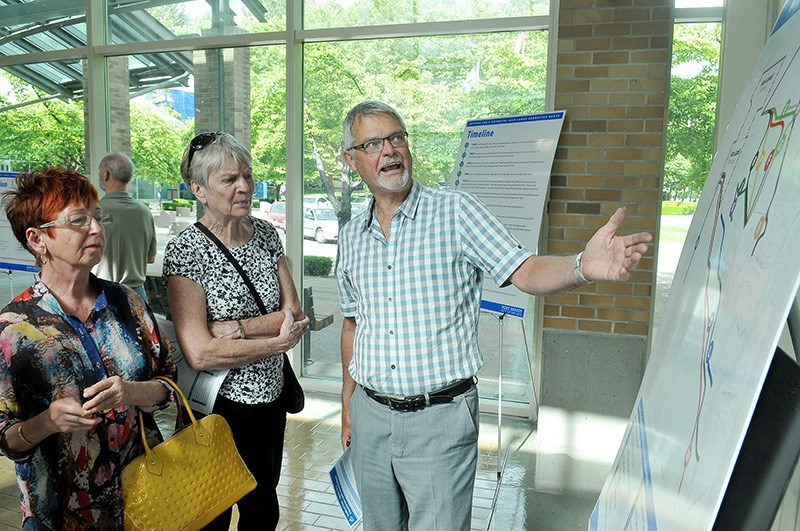Don’t expect a bridge across Burrard Inlet or a tunnel underneath Bert Flinn Park in Port Moody to relieve the increase in traffic that is anticipated if and when the Ioco Lands are developed.
But an extension of David Avenue along the right of way that already bisects the park is still in the cards as one of five options deemed suitable for further analysis in an independent technical study commissioned by the city to investigate possible alternatives to putting a road through the 311-acre green space. The results of that study were on display at an open house at city hall on Monday.
The report, by ISL Engineering, examined 16 potential routes to improve the connection between the Ioco Lands and Inlet Centre. Currently Ioco Road is the most direct link, but traffic along that route could increase significantly with development of the Ioco Lands that were acquired from Imperial Oil in 2015 by Brilliant Circle Group, said the report.
The developer has yet to make an application to develop the 250-acre property that includes the old Ioco townsite where employees of the refinery once lived. Last year it held a series of public consultations and open houses to gather feedback on its proposals to construct a new residential and commercial neighbourhood with improved access to the waterfront.
A right of way to extend David Avenue westward has been part of Port Moody’s official community plan for decades, but in 1999 the city turned the green space that straddles that route into Bert Flinn Park following a referendum. A proposal to build out that right of way into a connector road sparked protests and in Sept., 2016, city council directed staff to prepare a report into possible connector routes.
Using the right of way through the park still makes sense, said ISL in its report. It would relieve traffic congestion along Ioco and East roads, create more capacity for greater development of the Ioco Lands and provide improved access for pedestrians and cyclists as well as roadside parking for trail users. Construction of the road would cost about $50 million.
But the route would have an impact on trails in Bert Flinn Park as well as the movement of wildlife, according to the study. It would also require the acquisition of private property in the village of Anmore as well as the construction of a 250-metre bridge across Mossom Creek.
Relying on existing roads like Ioco and Sunnyside would spare the park and wouldn’t cost anything, said the report, but they would become busier, noisier and more polluted if the Ioco Lands are developed.
The status quo would also mean less capacity for development of the Ioco Lands and no opportunity to improve conditions for pedestrians and cyclists.
A third option to make improvements to Ioco Road like adding a second left turn lane at Ungless Way and installing traffic signals at Maude Road, Kicking Horse Way and April Road would improve access but not capacity or conditions for pedestrians, cyclists and residents along the already busy route.
An option for a new route that skirts the northern and eastern edges of the park by connecting Lundlow Lane to Strong Road and then down to David Avenue has already raised the ire of the village of Anmore, which said in a letter sent to Port Moody’s mayor and council on May 8 it would increase traffic along its local roads and impact “our residents substantially.”
ISL’s report acknowledged the impact of the that route on residents of the village, along with various incursions into Bert Flinn Park, but it also said it would improve access not only to the Ioco Lands but for Anmore as well. It estimated such a new road would cost about $50 million to build.
A fifth option would rely upon a combination of strategies like improved transit services, subsidized transit passes, shuttles, car share services, better facilities for cyclists and pedestrians, and the encouragement of more mixed-use development in the area so residents don’t have to travel so much to access services and amenities to manage traffic demands in the area. The report recommended many of those ideas should be implemented no matter which connector route is ultimately chosen.
Among the options rejected by the report because they’re too expensive or because of property constraints are a bridge across Burrard Inlet that would cost about $1 billion to build, a tunnel underneath the park that the report said would be so expensive it’s unlikely the scale of development for the Ioco Lands would make it financially worthwhile, or building a road along the railway right of way just below Ioco Road.
Several other routes were also deemed to have minimal potential to attract traffic from the Ioco Lands.
The city is collecting feedback from the open house, as well as online, until June 18. The report, along with the feedback, will be presented to council in July.



